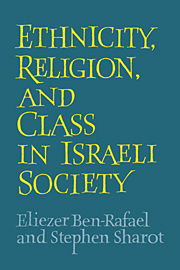Book contents
- Frontmatter
- Contents
- Acknowledgments
- I Theoretical and empirical background
- 1 Ethnicity and society
- 2 Divisions in Israeli society
- 3 Theoretical perspectives in Israeli sociology
- 4 The sample, its background, and its setting
- II Social patterns and behavior
- III Identities and images
- IV The impact of stratification
- V Social cleavages: an overview of Israeli society and some theoretical implications
- Appendix A The sample
- Appendix B Deprivation index
- Appendix C Indexes of ethnic identification
- Glossary
- Notes
- References
- Index
2 - Divisions in Israeli society
Published online by Cambridge University Press: 12 September 2009
- Frontmatter
- Contents
- Acknowledgments
- I Theoretical and empirical background
- 1 Ethnicity and society
- 2 Divisions in Israeli society
- 3 Theoretical perspectives in Israeli sociology
- 4 The sample, its background, and its setting
- II Social patterns and behavior
- III Identities and images
- IV The impact of stratification
- V Social cleavages: an overview of Israeli society and some theoretical implications
- Appendix A The sample
- Appendix B Deprivation index
- Appendix C Indexes of ethnic identification
- Glossary
- Notes
- References
- Index
Summary
More than forty years after its establishment as a state, Israel may still be considered the youngest society in the world because nearly 40% of its Jewish citizens were not born in the country. No single group from a particular country or origin is dominant demographically. The largest group of origin is the Moroccans; the Moroccan first and second generation make up 13% of the population. They are followed by the Russians, Poles, Rumanians, and Iraqis (each group comprising 7% to 8%). Various other groups, such as the Yemenites, Germans, and Hungarians each account for between 2% and 5% of the population, while still others, such as the Bulgarians and the Greeks, reach only 1% or 2%. Israel's English, French, or North American Jews number even less. Of the Jewish population, 21% is third generation or more, and Jews of eastern European descent are likely to be the largest group in the adult section of this category.
The Israeli-Jewish ethnic landscape is an intricate one, but it has been simplified (and often oversimplified) by collapsing the various groups into two broad categories: Ashkenazim, who came mainly from European countries, and Mizrachim or edot ha'Mizrach, who came from North African and Asian countries.
- Type
- Chapter
- Information
- Ethnicity, Religion and Class in Israeli Society , pp. 24 - 35Publisher: Cambridge University PressPrint publication year: 1991



